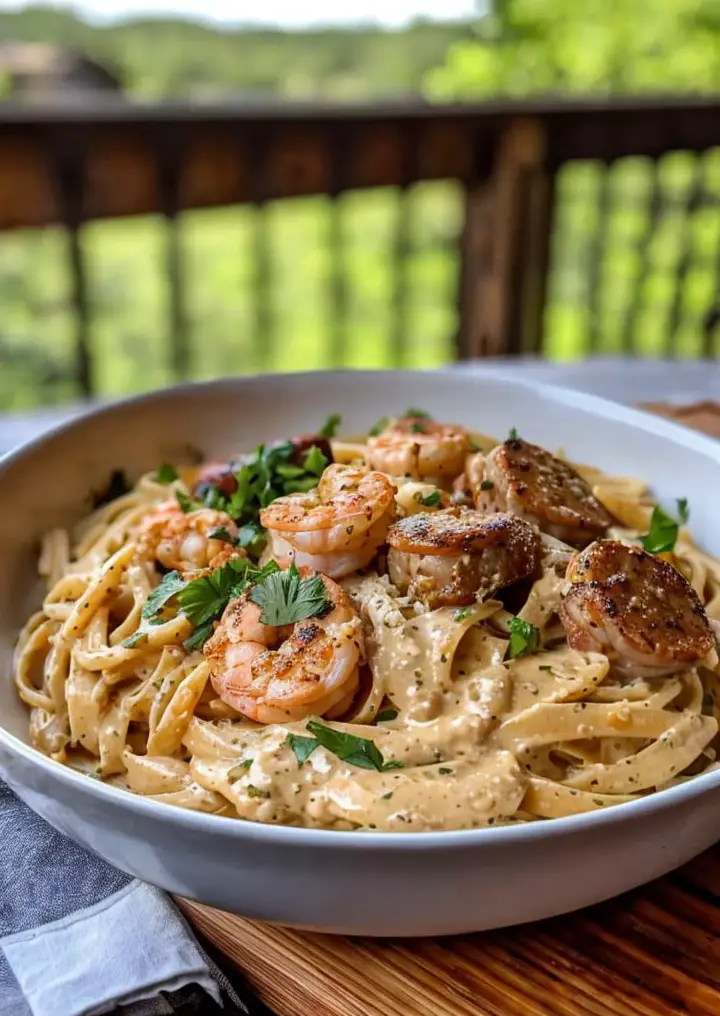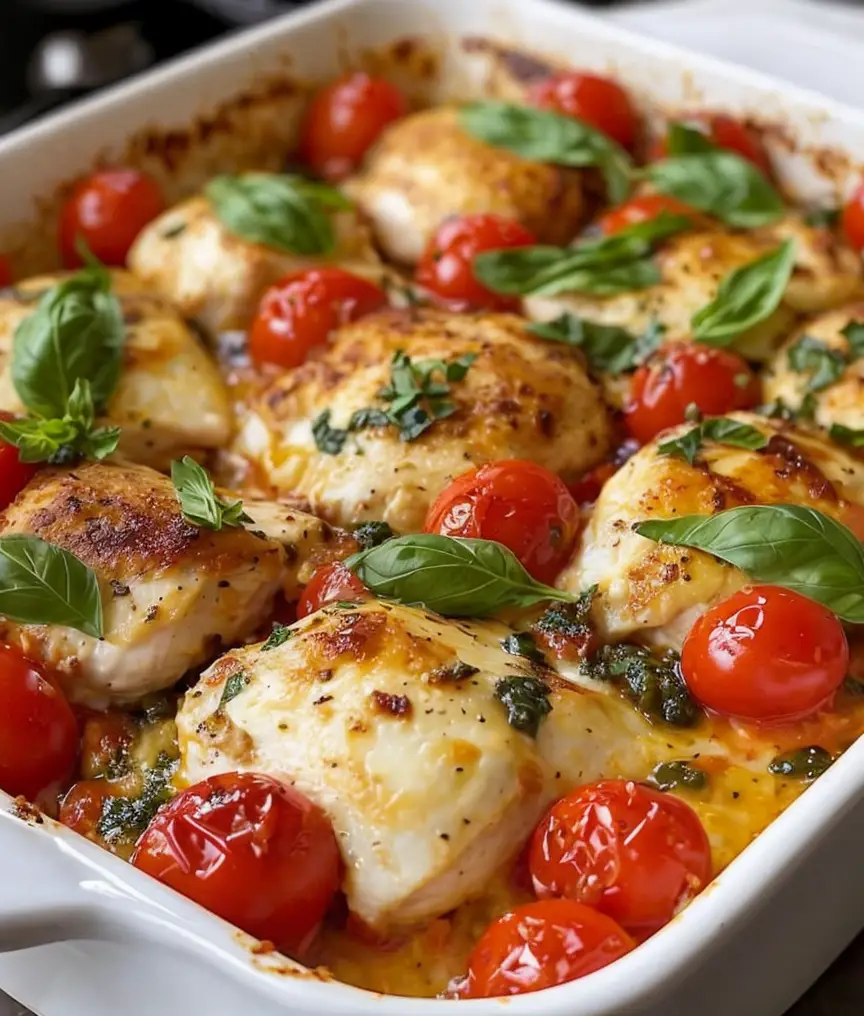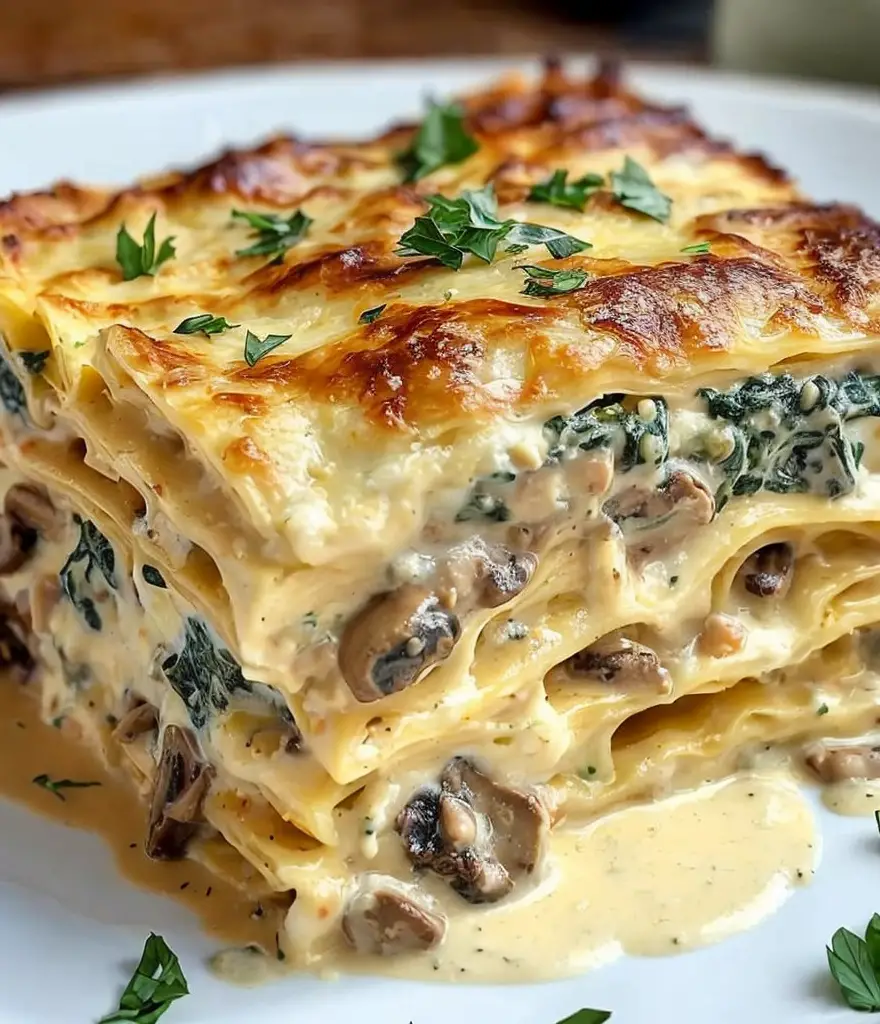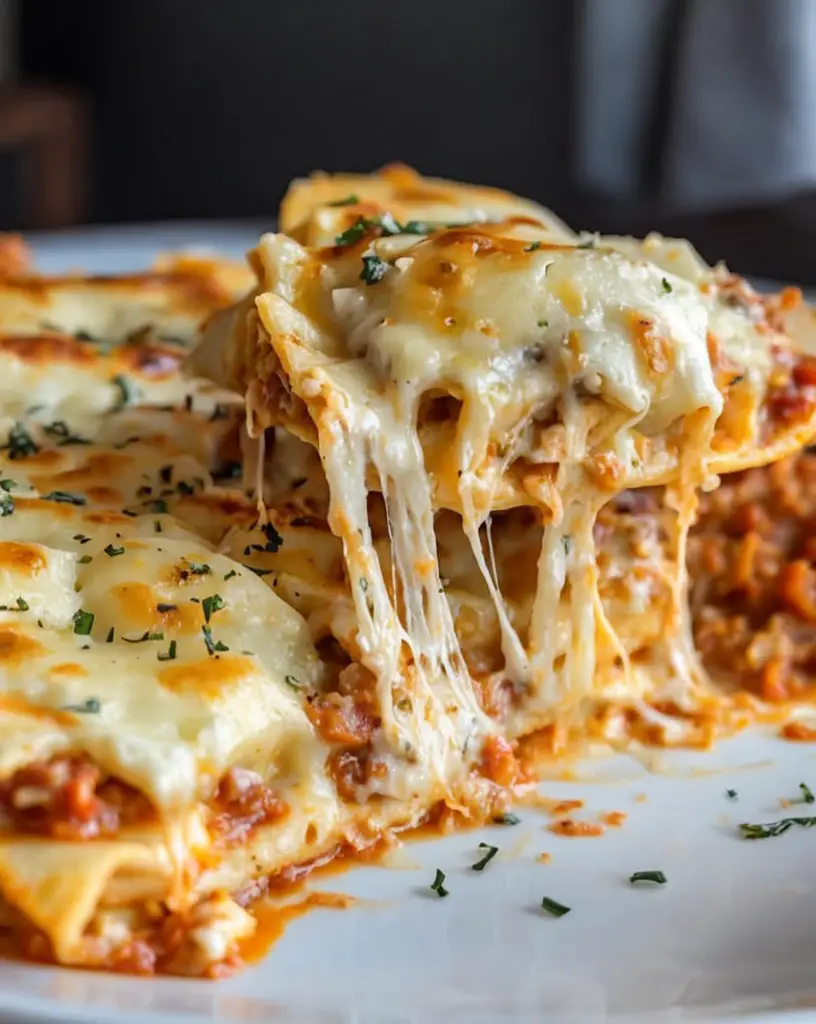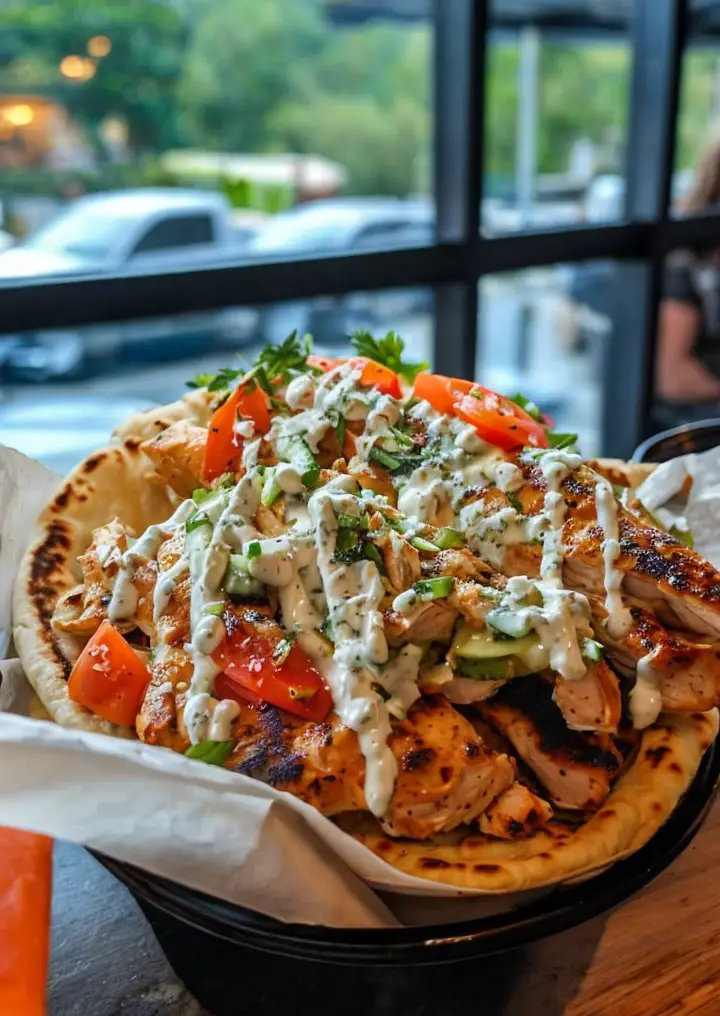Quick and Cheesy Garlic Chicken Wraps: A Deliciously Easy Meal
Quick and Cheesy Garlic Chicken Wraps are your go-to solution for a flavorful and satisfying meal that comes together in just 25 minutes. Perfect for busy weeknights or as a comfortable lunch, these wraps are loaded with tender chicken, melted cheese, and the irresistible aroma of garlic that wafts through your kitchen. Not only do these wraps deliver on flavor, but they are also easy to customize, making them a family favorite for all ages.
Imagine biting into a warm, soft tortilla filled with juicy chicken, a blend of gooey cheese, and fresh veggies, all finished with a zesty garlic sauce. Each bite is an explosion of flavors and textures that will have your taste buds dancing. Whether you’re looking for a quick meal to whip up after work or a filling dish to share with friends, these Quick and Cheesy Garlic Chicken Wraps are sure to impress!
Quick Recipe Highlights
- Flavor Profile: Rich and savory with a garlic kick.
- Texture: Creamy cheese, tender chicken, and crunchy veggies create a delightful contrast.
- Aroma: The garlic and cheese meld together to create an irresistible scent that fills your home.
- Visual Appeal: Vibrant colors from the fresh veggies make these wraps as beautiful as they are delicious.
- Skill Level Needed: Suitable for beginners and experienced cooks alike.
- Special Equipment: A stovetop skillet for cooking and a cutting board for prep.
Recipe Overview
- Difficulty Level: Easy—This recipe requires minimal chopping and straightforward cooking techniques that make it accessible for everyone.
- Category: Ideal for lunch, dinner, or meal prep options.
- Cuisine: A delightful fusion influenced by classic American and Mexican flavors, creating a unique wrap experience.
- Cost: Budget-friendly, with approximate costs under $20 for the entire meal.
- Season: Perfect for any season, but especially appealing during the warmer months for lightweight and fresh eating.
- Occasion: Great for casual family dinners, picnics, or as a party appetizer.
Why You’ll Love This Recipe
Quick and Cheesy Garlic Chicken Wraps balance flavor, convenience, and nutrition, making them a standout in any weeknight meal rotation. The delicious combination of tender chicken and garlic-infused cheese will certainly become a weeknight staple for families seeking both flavor and ease. From the moment the garlic hits the pan, you’ll be greeted by a mouth-watering aroma that builds anticipation.
Furthermore, the wrap format allows for versatility—feel free to add your favorite vegetables like bell peppers, spinach, or even a hint of hot sauce for a spicy kick. It’s a great way to sneak in some veggies while still keeping the meal comforting and satisfying.
Nutritionally, these wraps suit a variety of dietary preferences. You can easily substitute with grilled veggies for a vegetarian version or opt for gluten-free tortillas, making it approachable for those with dietary restrictions.
Whether you’re entertaining guests or cooking for a small family, these wraps are as fun to prepare as they are to eat. Their simple ingredients and quick assembly make these wraps perfect for social gatherings, ensuring that both you and your guests remain satisfied.
Finally, the cost-effectiveness of the Quick and Cheesy Garlic Chicken Wraps adds to their charm. Utilizing everyday ingredients and quick cooking methods, this dish proves you don’t have to overspend to enjoy a delicious meal.
Historical Background and Cultural Significance
The roots of wraps can be traced back to various culinary traditions worldwide, where flatbreads have long been used to encase meats and vegetables. The concept of a wrap combines the simplicity of traditional ingredients with contemporary flair, making it a beloved choice in modern cuisine.
Culturally, wraps are versatile and have evolved to accommodate various flavors from different cuisines, showcasing a blend of global culinary practices. This recipe, focusing on the popular combination of garlic and cheese, reflects the American love for rich flavors while incorporating elements from Mexican cooking.
Over time, wraps have transformed from simple sandwiches to gourmet experiences, allowing chefs and home cooks alike to experiment with fillings and sauces. Today, they remain a staple in many households, especially for those who value quick preparation without sacrificing flavor.
Regional variations of wraps continue to flourish, from Mediterranean shawarma to Asian-inspired burritos, demonstrating how adaptable this meal format is across cultures. The Quick and Cheesy Garlic Chicken Wraps stand as a testament to that adaptability while retaining an unmistakable comfort food appeal.
Ingredient Deep Dive
Chicken: Chicken is a staple protein in many cuisines, known for its versatility and mild flavor. It offers numerous nutritional benefits, such as being low in fat and high in protein. When selecting chicken, look for fresh, high-quality cuts without added preservatives. Store raw chicken in the fridge for up to two days, or freeze for longer preservation. If you’re out of chicken, turkey or tofu can serve as excellent substitutes.
Garlic: Garlic has been used for centuries, not only for its flavor but also for its health benefits, including anti-inflammatory and immune-boosting properties. Fresh garlic bulbs should feel firm, while pre-peeled cloves or garlic paste can be convenient alternatives. To enhance the flavor of your dish, store garlic in a cool, dry place, but avoid exposing it to moisture. If you’re in a pinch, garlic powder can also provide a decent flavor, although with less freshness.
Common Mistakes to Avoid
- Overcooking the chicken can lead to dry wraps; always cook just until tender.
- Using too much garlic can overpower the other flavors; balance is key.
- Skipping the resting time after cooking can make the chicken chewy.
- Choosing the wrong type of wrap can affect texture; opt for soft flour tortillas for the best experience.
- Crowding the cooking pan leads to uneven cooking; work in batches if necessary.
- Not warming the wraps can make them stiff; gently heat for better pliability.
- Forgetting to season your vegetables can lead to blandness; sprinkle salt and pepper for better flavor.
- Using pre-shredded cheese can lead to a less creamy melt; fresh is best.
- Skipping the garnish can miss out on vibrant color and extra flavor from herbs.
- Rushing the assembly can result in falling apart wraps; take your time to ensure a tight roll.
Essential Techniques
Grilling Chicken: Proper grilling technique is crucial for achieving juicy chicken. Preheat your grill or skillet to medium-high, and ensure the chicken pieces are about the same size for even cooking. Avoid constant flipping, allowing the chicken to develop a beautiful sear. Look for visual cues like juices running clear and golden-brown color to know it’s done.
Wrap Assembly: Mastering the wrap technique ensures all ingredients are nicely enclosed. Start by placing fillings in the center, fold in the sides, and roll tightly from the bottom up. Practice makes perfect—check the tightness and adjust as necessary to avoid spills.
Pro Tips for Perfect Quick and Cheesy Garlic Chicken Wraps
Add a splash of lemon juice for a refreshing zing and to brighten the overall flavor of your wraps.
Consider marinating the chicken beforehand for at least 30 minutes to infuse deeper flavors.
Experiment with different cheese types like pepper jack or mozzarella for varied textures and tastes.
Enhance the dressing by adding herbs like cilantro or parsley to incorporate freshness.
For a colorful presentation, layer in a variety of vegetables such as shredded lettuce, diced tomatoes, or avocado.
You can quickly double or triple the recipe for larger gatherings or meal prep for the week ahead.
Include a drizzle of your favorite hot sauce if you enjoy a bit of heat.
Don’t be afraid to let the children help with assembly for a family-friendly cooking experience.
Variations and Adaptations
Consider regional variations by incorporating local ingredients; try using feta cheese and olives for a Mediterranean twist or BBQ sauce and cheddar for a Southern-style wrap.
Incorporate seasonal adaptations by adding fall vegetables like roasted butternut squash in autumn or fresh greens during spring for a light, refreshing wrap.
For dietary modifications, opt for gluten-free tortillas or use lettuce leaves for a low-carb version.
If you’re eager for flavor variations, experiment with different spices like smoked paprika or chili powder in your seasoning mix.
Texture modifications can play a huge role; try adding crunchy ingredients like tortilla chips or nuts for an unexpected crunch.
Presentation alternatives can enhance appeal; try stacking wraps vertically and securing them with a skewer for a fun party platter.
Serving and Presentation Guide
Plating techniques can significantly enhance your dining experience; try cutting the wraps in half on a diagonal for an attractive presentation that showcases their contents.
Add garnishing ideas such as a sprinkle of fresh herbs or a drizzle of ranch dressing to bring out colors and flavors.
Classic accompaniments include a side of crispy chips or a fresh salad for an all-in-one meal.
For a modern serving suggestion, consider serving wraps with a selection of dipping sauces, such as salsa, guacamole, or garlic aioli.
Temperature considerations are essential; serve these wraps warm for the best flavor profile.
Portion control tips can help manage servings; aim for about one and a half wraps per person depending on appetite.
Wine and Beverage Pairing
Consider white wines like a chilled Sauvignon Blanc or a light Chardonnay to complement the garlic flavors without overwhelming them.
If you prefer non-alcoholic alternatives, a refreshing sparkling water with a slice of lime can cleanse your palate beautifully.
For a warmer beverage selection, an herbal tea can provide a soothing balance post-meal.
Temperature considerations are key; serve whites well-chilled to enhance the overall dining experience.
Creative serving suggestions might include offering unique infusions such as a homemade lemonade for a refreshing day-time pairing.
Storage and Shelf Life
Storage methods for your wraps are straightforward; store them wrapped in plastic in the refrigerator for up to three days.
Temperature requirements are vital; always ensure leftovers cool before refrigeration to avoid spoilage.
Container recommendations include airtight containers to maintain optimal freshness. For longer storage, consider freezing individual wraps.
Signs of spoilage include off-smells, discoloration, or mold; trust your senses!
Reheating instructions are simple; microwave briefly to reheat but avoid overcooking which can dry them out.
Freezing guidelines suggest placing wraps in freezer-safe bags for up to two months, ensuring keeping them flat to avoid freezer burn.
Make Ahead Strategies
A recommended prep timeline includes marinating chicken the night before for maximum flavor.
Storage between steps is advantageous; prep veggies in advance and store separately to maintain freshness.
Quality impact assessment indicates prepped ingredients can be assembled right before serving for the best result.
For assembly tips, consider rolling wraps ahead of time and storing in the refrigerator for an easy grab-and-go lunch.
Reheating guidelines suggest wrapping them in a damp paper towel to prevent drying out.
Fresh elements like avocados should be added just before serving to avoid browning.
Scaling Instructions
Halving the recipe is easy; simply use half the amount of all ingredients while keeping the cooking method the same.
For doubling or tripling, consider using a larger cooking surface like a grill or griddle to maintain cooking efficiency.
Equipment adjustments may be necessary; larger pans for increased ingredients can also help with cooking time efficiency.
Timing modifications will likely require a bit more patience due to increased quantity, so check doneness thoroughly.
Storage considerations are crucial with larger batches; ensure proper containers are used for freezing to avoid excess air exposure.
Nutritional Deep Dive
Macro breakdown reveals balanced protein from chicken, healthy fats from cheese, and carbohydrates from tortillas.
Micronutrient analysis indicates these wraps provide valuable vitamins and minerals depending on vegetable additions.
Health benefits include a good source of lean protein while being low in saturated fats compared to traditional fried meals.
Dietary considerations can help manage health needs; consider these wraps versatile for various dietary preferences.
Portion analysis suggests moderation with extras like sauces for a balanced meal.
Weight management tips indicate opting for smaller wraps if portion control is a priority.
Dietary Adaptations
For gluten-free versions, utilize corn or similar gluten-free tortillas, ensuring an accessible meal for all.
Dairy-free adaptations can swap cheese for plant-based options while ensuring flavor remains primary.
For vegan preferences, replace chicken with hearty vegetables or a plant-based protein option.
Low-carb adaptations using lettuce wraps instead of tortillas can help adhere to specific dietary needs without sacrificing flavors.
Following keto specifications may involve adjusting ingredient ratios to emphasize fat content while minimizing carbohydrates.
Paleo modifications suggest swapping conventional ingredients for whole foods, focusing on fresh vegetables and meats.
Low-FODMAP ingredients can be streamlined by avoiding garlic and opting for infused oils instead.
Lastly, accommodating other specific diets allows for adjustments to meet diverse nutritional requirements while retaining joy in cooking.
Troubleshooting Guide
Texture issues may arise if chicken is overcooked, resulting in a dry bite; ensure perfect cook time to retain moisture.
Flavor balance can be affected by improper seasoning; always taste and adjust as you cook, incorporating spices gradually.
Temperature problems often occur in reheating; a gentle approach with medium heat retains quality without drying out.
Equipment challenges, like uneven heating on the stovetop, can be solved by monitoring pans closely for even cooking.
Ingredient substitutions should be methodical; always assess how changes might impact overall flavor and texture.
Timing concerns arise when juggling multiple ingredients; prep as much ahead of time to streamline the cooking process and avoid last-minute stress.
Recipe Success Stories
Community feedback from family gatherings often highlights these wraps as the standout dish of any event, with requests for more.
Variation successes are frequently reported; many readers love swapping chicken for roasted vegetables or shredded beef for added excitement.
Adaptation stories reveal how easy it can be to cater to dietary needs without losing flavor, making them a family favorite.
Reader suggestions often include fun additions like jalapeños for a spicy twist, adding a personal touch to each meal.
Photography tips encourage showcasing vibrant veggies and oozing cheese to entice viewers to these delicious wraps.
Frequently Asked Questions
Q1: Can I make the wraps ahead of time?
A1: Absolutely! You can assemble the wraps a few hours in advance and store them in the fridge. Just add any fresh ingredients like avocado just before serving to keep their texture.
Q2: What type of cheese works best?
A2: For a gooey, melty texture, mild cheddar or mozzarella are great choices. Feel free to experiment with your favorites!
Q3: Are these wraps freezer-friendly?
A3: Yes, they are freezer-friendly! Just wrap them in plastic and place them in a freezer-safe container, and they’ll last for up to two months.
Q4: Can I use turkey instead of chicken?
A4: Definitely! Ground turkey or sliced turkey breast can make a delicious alternative while keeping the dish flavorful.
Q5: What’s the best way to cook the chicken?
A5: You can grill, bake, or sauté the chicken. Grilling or sautéing gives the best flavor and texture.
Q6: Is this dish suitable for kids?
A6: Yes, the flavors are mild and very appealing to kids. You can also let them customize their own wraps for extra fun!
Q7: How can I make it vegetarian?
A7: Replace the chicken with a variety of vegetables or beans for a hearty vegetarian option.
Q8: What’s the cooking time if I double the recipe?
A8: The cook time remains mostly the same, but you might need to cook in batches to ensure everything is evenly cooked.
Q9: Can I use leftover chicken?
A9: Leftover chicken works great! Just warm it before assembling the wraps to save time and maximize flavor.
Q10: What other veggies work in this recipe?
A10: Feel free to incorporate diced bell peppers, shredded carrots, or spinach for extra nutrition and color.
Additional Resources
For those looking to expand their culinary repertoire, consider checking out related recipes like Chicken Fajitas or Veggie Quesadillas that utilize similar ingredients and flavors.
Technique guides are also beneficial, particularly for mastering cooking chicken, which is essential for many dishes.
Ingredient information on spices or sauces can help elevate your cooking game; explore how herbs can enhance your meal.
Equipment recommendations include the best skillet or grill pan for achieving perfectly cooked chicken and wraps.
Seasonal variations can inspire creativity; consider fresh summer veggies or fall spices to vary your meals throughout the year.
Join the Conversation
We’d love for you to share your recipes on social media! Tag us to showcase your photos of Quick and Cheesy Garlic Chicken Wraps and inspire others. Engaging in recipe reviews below can provide feedback for improvement and encouragement to fellow home cooks.
Consider sharing your unique variations or personal touches in the comments, as they can ignite new ideas for all readers! Let’s build a community centered around delicious food and fun cooking experiences together. Dishing out your successes or challenges can help others perfect their own cooking skills.
The Recipe
Quick and Cheesy Garlic Chicken Wraps
Serves: 4
Prep Time: 10 mins
Cook Time: 15 mins
Total Time: 25 mins
Kitchen Equipment Needed
- Skillet or grill pan
- Cutting board
- Knife
- Measuring cups and spoons
Ingredients
- 2 chicken breasts, diced
- 1 cup shredded cheese (cheddar or mozzarella)
- 4 large flour tortillas
- 2 cloves garlic, minced
- 1 tablespoon olive oil
- Salt and pepper to taste
- Optional: diced vegetables (such as bell peppers or onions)
Directions
- In a skillet, heat olive oil over medium heat. Add diced chicken and garlic, seasoning with salt and pepper.
- Cook for 5-7 minutes until the chicken is cooked through and no longer pink.
- If using, add the diced vegetables and cook for another 2-3 minutes until tender.
- Reduce heat and sprinkle cheese over the chicken mixture; cover until cheese melts.
- Remove from heat and let cool slightly before assembling the wraps.
- Place cheese and chicken mixture in the center of each tortilla, then fold over the sides and roll tightly.
- Toast the wraps in the skillet for an additional 2 minutes on each side until golden brown.
- Slice in half and serve warm with your favorite toppings.
Recipe Notes
- Feel free to swap chicken for shrimp or beef to change up the protein.
- Add different spices such as cumin or paprika to give a unique twist.
- These wraps can be enjoyed with a side salad or chips for a complete meal.

